This post may contains affiliate links. Read our full disclosure here.
Creating an earthy kitchen feels like bringing the outdoors inside, where natural textures and warm tones create a space that nourishes both body and soul. You’ll discover how wood, stone, and organic shapes transform your cooking space into a calming retreat. This isn’t about following trends—it’s about crafting a kitchen that reflects your connection to nature and your love for authentic living.
Whether you’re planning a complete renovation or simply refreshing your current space, this guide will walk you through practical earthy kitchen ideas that work for any budget. From choosing the right materials to adding those perfect finishing touches, you’ll learn how to create an organic kitchen style that feels both modern and timeless. Let’s explore how to build a kitchen where every meal becomes a moment of grounded comfort.
What Makes an Earthy Kitchen Design Special
A true earthy kitchen design goes beyond just using brown and green colors—it’s about creating harmony between function and natural beauty. The natural kitchen aesthetic focuses on materials that age gracefully and surfaces that tell stories through their imperfections. You’ll find yourself drawn to the warmth of reclaimed wood, the cool touch of natural stone, and the gentle texture of woven elements.
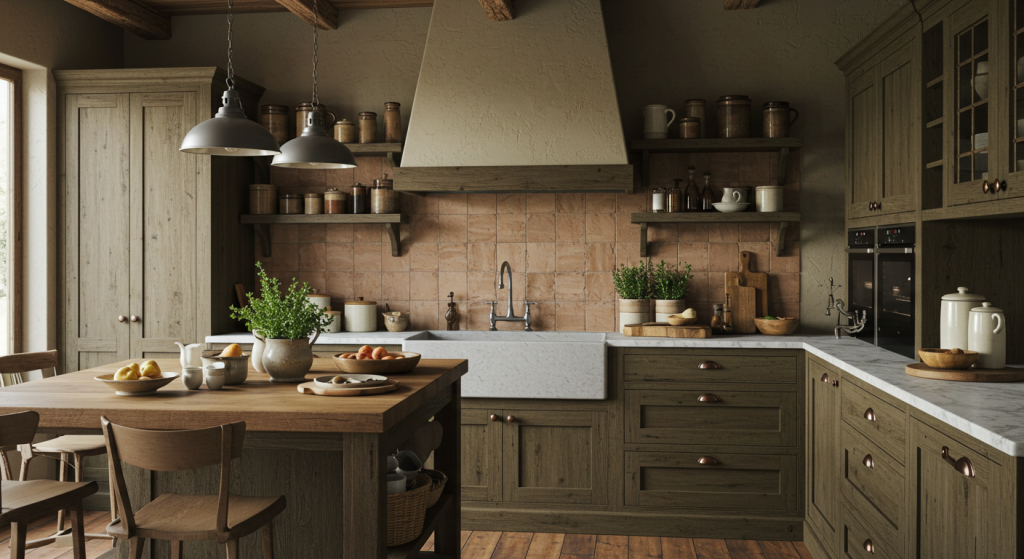
The foundation of any earthy kitchen lies in choosing materials that connect you to the earth. Wood cabinetry brings warmth and character, while stone countertops add both durability and visual weight. Linen textiles soften hard surfaces, and clay pottery adds handmade charm. These elements work together to create a space that feels both grounded and welcoming.
Unlike sleek modern kitchens that prioritize shine and perfection, an earth-toned kitchen celebrates texture and patina. Matte finishes replace glossy surfaces, and raw edges take precedence over polished lines. This approach creates a space where you can relax and enjoy the cooking process without worrying about maintaining a pristine appearance. The goal is comfort that invites you to linger over morning coffee or gather friends for casual meals.
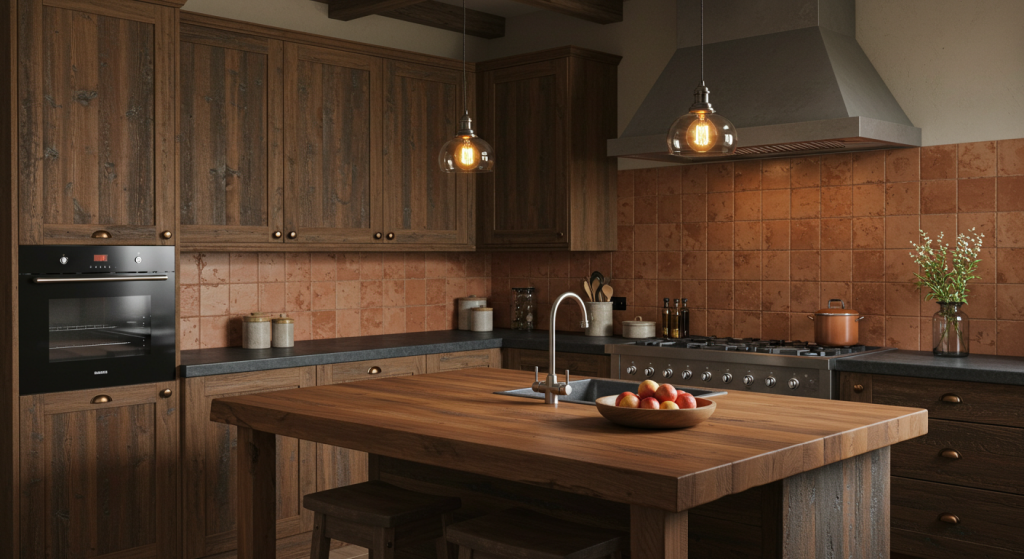
Choosing the Right Materials for Your Earthy Kitchen
Building a kitchen with natural materials starts with selecting elements that have genuine character and substance. Oak, walnut, and reclaimed wood bring unmatched warmth to cabinetry and open shelving. These woods develop beautiful patinas over time, making your kitchen feel more personal and lived-in with each passing year. Consider butcher block countertops for food prep areas—they’re practical, beautiful, and improve with age when properly maintained.
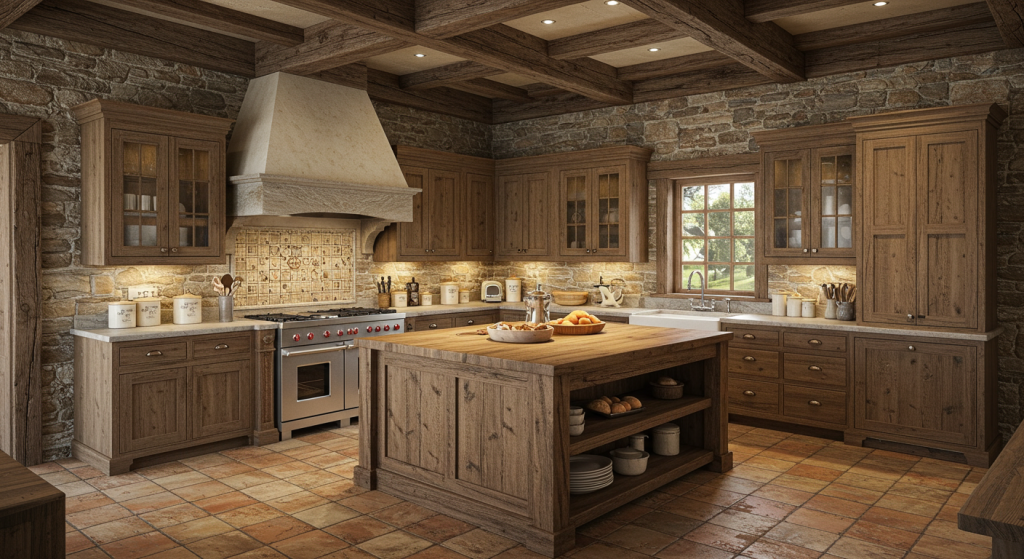
Stone elements ground your earthy kitchen with their timeless appeal and natural variations. Slate tiles create dramatic backsplashes that pair beautifully with warm wood tones, while honed granite countertops offer durability without the high-gloss finish of polished stone. Limestone and travertine floors add texture underfoot and work well with radiant heating systems for ultimate comfort during colder months.
Don’t overlook the power of natural textiles in creating a wood and stone kitchen that feels complete. Linen window treatments soften harsh angles and filter light beautifully throughout the day. Hemp dish towels and unbleached cotton table runners add layers of texture without overwhelming the space. These materials also improve with use, developing the kind of character that makes your kitchen feel like home rather than a showroom.
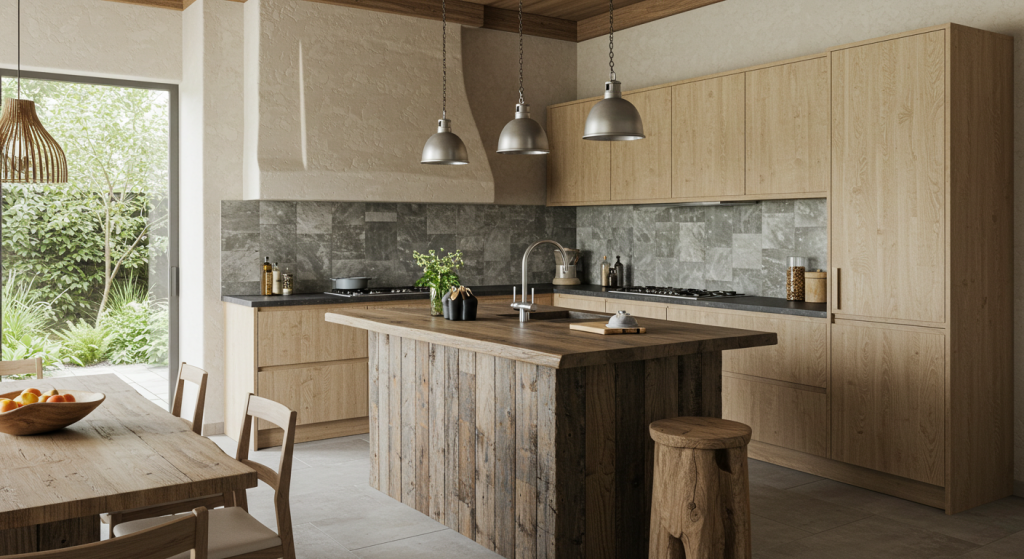
The key to successful earthy kitchen ideas lies in mixing refined and raw finishes thoughtfully. Pair smooth river rock backsplashes with rough-hewn wood beams, or combine polished concrete countertops with distressed cabinet hardware. This contrast creates visual interest while maintaining the organic feel that defines the aesthetic. For those interested in a minimalist aesthetic at home, choose fewer materials but let each one make a stronger statement.
Color Palettes That Bring Warmth to Your Space
Creating an inviting atmosphere starts with choosing warm kitchen colors that reflect the natural world around us. Olive green cabinets paired with honeyed wood countertops create a sophisticated yet approachable foundation. This combination works particularly well with cream-colored walls and brass hardware, creating depth without overwhelming the space. The secret lies in layering different shades of the same color family to build richness.
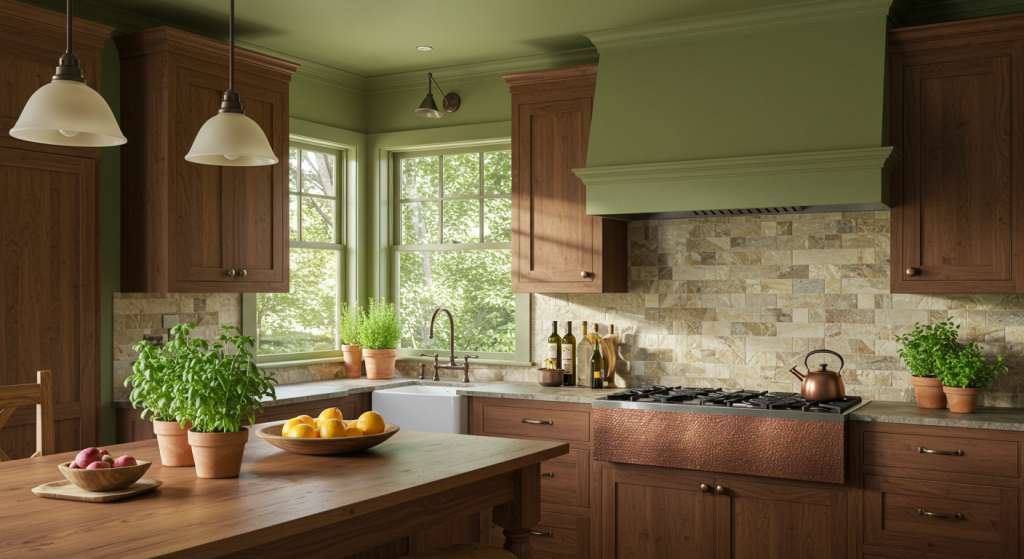
Terracotta and clay tones bring instant warmth to any earthy kitchen, especially when balanced with mushroom grays and soft creams. Consider painting your island in a rich terracotta shade while keeping perimeter cabinets in warm white or natural wood. This approach creates a focal point without making the space feel heavy or closed-in. Add touches of charcoal gray through hardware or light fixtures to ground the palette.
For those who prefer subtlety, a palette of earthy tones in kitchen design using warm whites, golden oak, and dusty sage creates a calming environment perfect for daily life. These colors age beautifully and won’t feel dated in five years. Test paint samples in various lighting conditions throughout the day—natural light reveals the true character of earthy colors better than artificial lighting alone.
The beauty of working with earth-toned kitchen colors lies in their forgiving nature and timeless appeal. Unlike trendy colors that might feel dated quickly, these natural hues adapt to changing seasons and evolving personal tastes. They also provide a perfect backdrop for colorful fresh produce, vibrant ceramics, and seasonal decor that changes throughout the year. Understanding how different rooms benefit from different palettes can help you create flow between your kitchen and adjacent spaces.
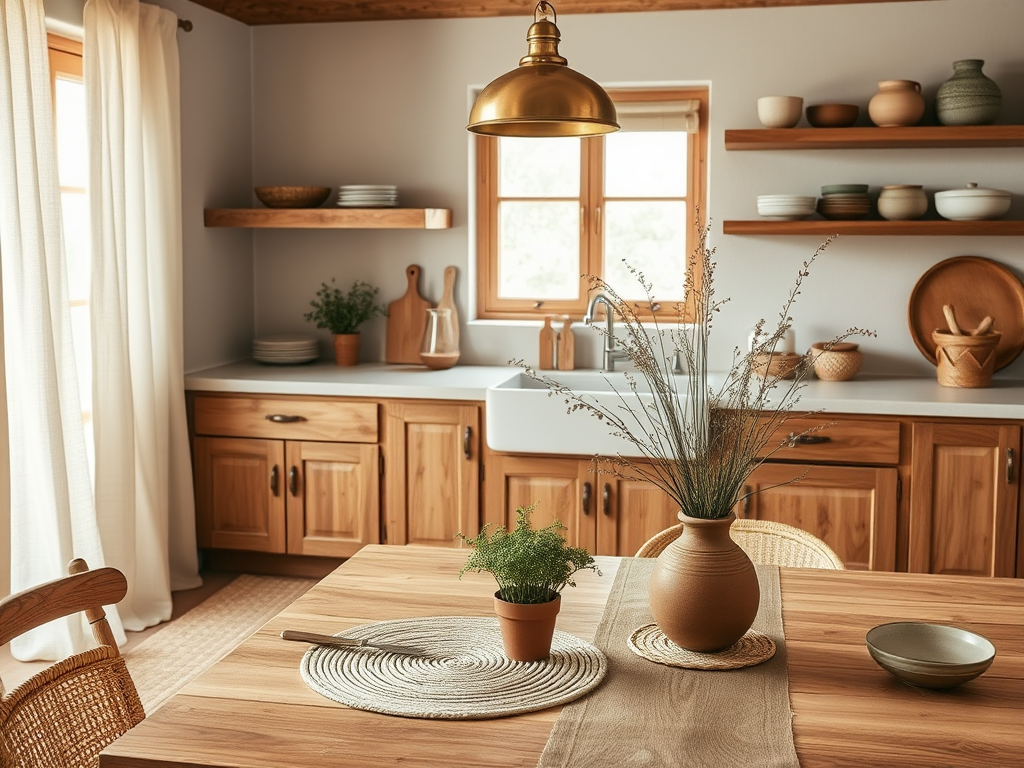
Creating an Indoor Kitchen Garden
Nothing connects you more directly to the earth than growing your own fresh herbs right on your countertop. An indoor kitchen garden transforms your cooking experience while adding life and fragrance to your space. Start with easy-to-grow herbs like basil, mint, parsley, and thyme that you’ll actually use in your daily cooking. Position these near your sink where you can easily water them and enjoy their aroma while working.
For those working with limited space or challenging lighting conditions, a smart herb planter takes the guesswork out of indoor gardening. The Click & Grow Smart Garden 3 fits perfectly on any countertop and provides automatic watering and LED growing lights. This system works beautifully in apartments or homes where natural light is limited, making it the best indoor garden for kitchen use in 2025.
Beyond herbs, consider adding trailing plants like pothos or string of hearts across open shelving to grow herbs in kitchen spaces while adding vertical interest. These plants thrive in kitchen environments with their higher humidity levels and ambient warmth. Small succulents in handmade ceramic pots also work well on windowsills, requiring minimal care while adding organic shapes and textures.
The kitchen garden system approach works particularly well for renters or anyone who wants fresh herbs year-round without outdoor garden space. These systems come with pre-seeded pods that eliminate the mess of traditional planting while ensuring successful growth. You can harvest fresh basil for your pasta or mint for your evening tea, creating a true farm-to-table experience in your earthy kitchen. This sustainable approach aligns perfectly with rustic home decor on a budget philosophy, adding both function and beauty without significant expense.
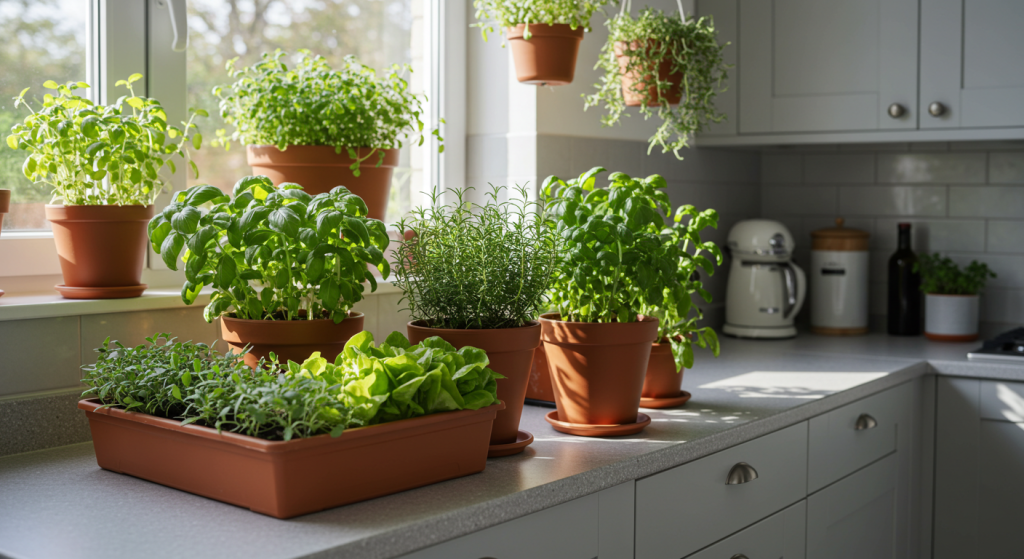
Setting the Mood with Natural Lighting and Textures
The right lighting transforms your earthy kitchen from a functional workspace into a gathering place where people naturally want to spend time. Warm-toned LED bulbs around 2700K create the golden glow that makes wood finishes come alive and natural materials look their best. Avoid cool, bright lighting that can make your carefully chosen earth tones appear flat or unwelcoming.
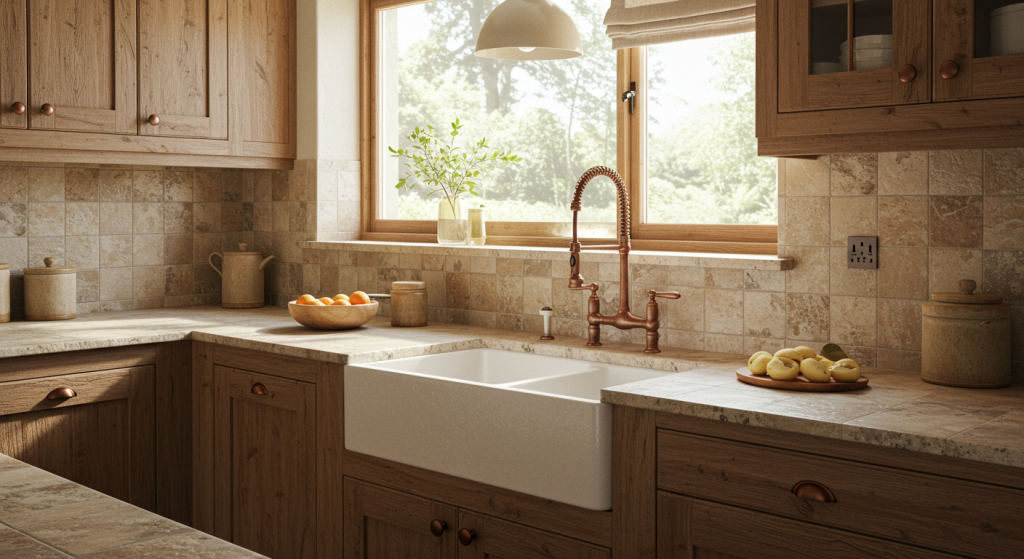
Pendant lights become sculptural elements that reinforce your natural aesthetic while providing task lighting where you need it most. Look for fixtures made from rattan, linen, hand-thrown clay, or aged brass that complement your material palette. These fixtures cast beautiful shadows and add visual interest even when not illuminated. Position them strategically over islands and prep areas to create pools of warm light that define different zones within your space.
Building kitchen with natural textures requires layering different materials thoughtfully throughout the space. Wooden cutting boards displayed on open shelves, ceramic mugs hanging from hooks, and woven placemats on the counter all contribute to the tactile richness that defines this aesthetic. These everyday items become decorative elements that reinforce the connection between function and beauty.
Adding soft textures balances the harder surfaces found in most kitchens while creating opportunities for seasonal changes. A jute rug near the sink provides comfort underfoot and visually defines the workspace. Linen curtains soften window frames and filter harsh sunlight throughout the day. These textile elements also absorb sound, making your kitchen feel quieter and more peaceful. The cozy kitchen style emerges naturally when you combine warm lighting with varied textures and thoughtful material choices. Those embracing minimalist home decor can achieve this look with fewer elements, focusing on quality over quantity.
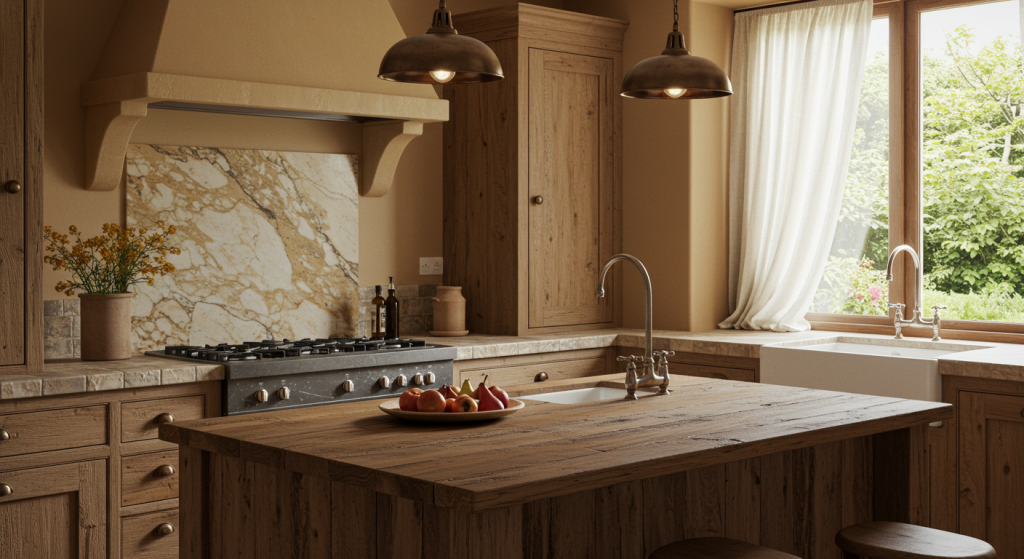
Finishing Touches That Complete Your Earthy Kitchen
The soul of your earthy kitchen decor often lies in the small, personal details that reflect how you actually live and cook. Dried flowers in vintage ceramic vases bring natural beauty without the maintenance of fresh arrangements. Choose varieties like wheat, eucalyptus, or lavender that complement your color palette and provide gentle fragrance. These arrangements change subtly over time, adding to the lived-in character that makes this aesthetic so appealing.
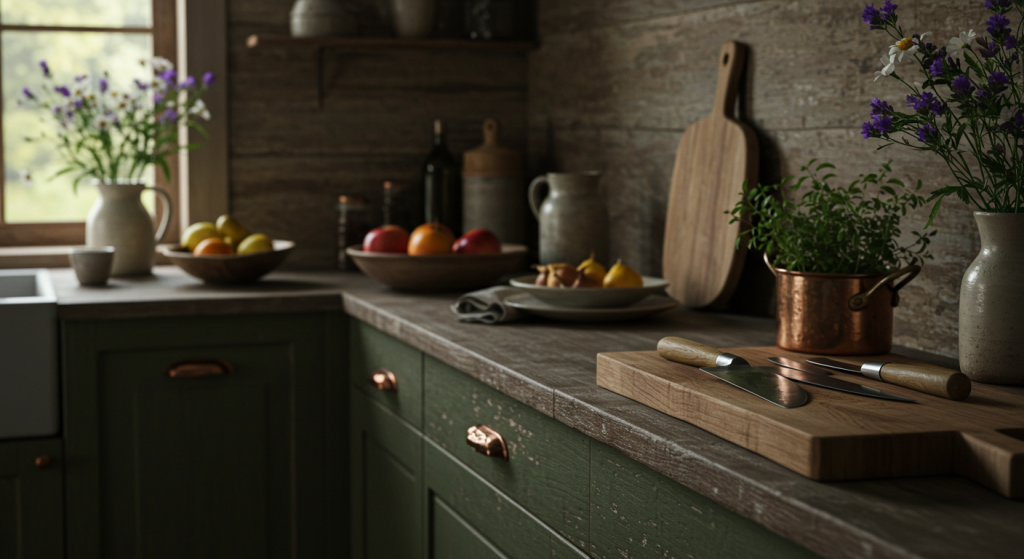
Open shelving provides the perfect opportunity to display your collection of handmade pottery, wooden serving pieces, and everyday items that double as decor. Arrange ceramic mugs by color or style, stack wooden cutting boards vertically for easy access, and group similar items in odd numbers for visual appeal. The key is balancing function with beauty—everything displayed should be something you actually use rather than just decorative items.
Embrace the imperfect and handmade elements that give your space character and warmth. A collection of mismatched vintage pottery tells a story, while handwoven baskets provide storage and texture simultaneously. Wooden spoons and cutting boards develop beautiful patinas with use, becoming more beautiful rather than showing wear. This approach to rustic kitchen inspiration celebrates the beauty found in everyday objects and honest materials.

Create seasonal vignettes that can evolve throughout the year without requiring major changes to your overall design. A wooden tray holds different elements each season—pinecones and branches in winter, fresh lemons and herbs in summer. Small ceramic bowls from local artisans can display seasonal produce or simply stand empty as sculptural elements. This flexibility keeps your cozy kitchen style feeling fresh while honoring the natural world’s changing rhythms. Drawing inspiration from Scandinavian home decor can help you edit your collections to showcase only the most meaningful pieces.
Bringing Your Earthy Kitchen Dreams to Life
Your earthy kitchen represents more than just a design choice—it’s a daily reminder to slow down and appreciate the simple pleasures of cooking, gathering, and nourishing yourself and others. By choosing natural materials, warm colors, and meaningful details, you’ve created a space that supports your well-being while reflecting your values. The beauty of this aesthetic lies in its ability to age gracefully, becoming more beautiful and personal with time.
Whether you’re harvesting herbs from your countertop herb garden, kneading dough on your wooden countertops, or simply enjoying morning coffee in the warm glow of your pendant lights, every moment in this space connects you to something deeper. The modern earthy kitchen proves that contemporary living and natural beauty can coexist beautifully.
Start with one element that speaks to you—perhaps a smart herb planter for fresh herbs or new pendant lights that cast warm shadows. Build your earthy kitchen gradually, allowing each addition to feel intentional rather than rushed. This approach creates a space that truly reflects your personality while honoring the timeless appeal of natural materials and organic forms.
The most successful earthy kitchen designs emerge from authentic choices rather than following trends, creating spaces that feel perfectly suited to the people who use them daily. Your kitchen should tell your story through the materials you choose, the objects you display, and the way you use the space for both everyday cooking and special celebrations.
What aspect of creating your earthy kitchen feels most appealing to you—is it the warm wood cabinetry, the fresh herbs growing on your counter, or the cozy lighting that makes every meal feel special? Share your plans and let’s inspire each other to create kitchens that truly nourish our daily lives.




